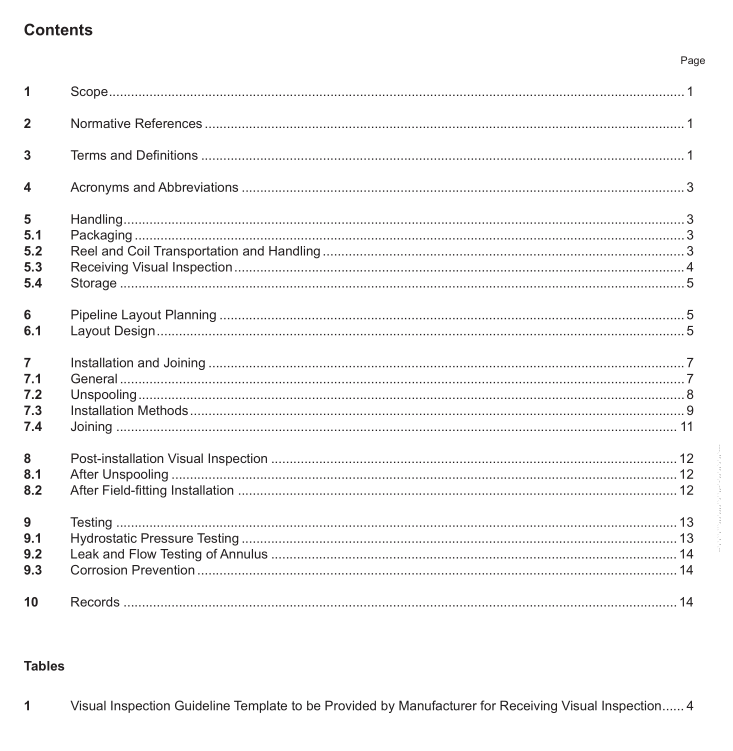API RP 15SIH pdf download

API RP 15SIH pdf download Installation and Handling of Spoolable Reinforced Line Pipe
Pipeline layout design shall be documented (e.g. with drawings showing pipe location and features such ascrossings, risers, or bends) and retained by the end user per Section 10.
6.1.1 Design Considerations
The following design considerations apply to pipeline layout planning:
a) During pipeline layout planning, the system designer appointed by the end user should consider the following
factors (which may lead to stresses or pipeline movementy:
1) thermal expansion and contraction (from anticipated temperature swings,including solar energy
absorption of the pipe body);
2) pipe pressurization;
3 transient pressure effects (e.g., water hammer);4) environmental hazards (e.g.. flooding, fire, animals);5) soil loading (e.g., vehicle loading, ground movement);
6) point loading (e.g., rocks or other pipes above or below the pipe);7) connections between spoolable and rigid pipe and surface equipment;8) pipeline anchor points, pipe supports, or thrust blocks.
b)The end user shall consider risks associated with pipeline system design, with particular emphasis on failure
mechanisms of surface lay pipe relative to a buried design. These failure mechanisms may include but arenot limited to third-party damage , impingement with another object during pipeline shifting , fire,UV damage,or freezing.
c) The end user shall consider risks associated with co-trenching with other pipelines or underground
infrastructure (i.e., adequate separation distances to avoid loading or thermal interference and provideclearances for future maintenance).
6.1.2 Bends
Bends in the pipeline system shall be designed with a radius greater than or equal to the operating MBR of theproduct, including consideration of the potential for pipeline movement or additional stresses.
Field-fittings shall not be installed in the bend zone. The pipe manufacturer shall provide the minimum distancebetween the beginning of the straight section of the bend and the field-fitting.
6.1.3 Crossings
The following requirements apply to crossings:
a) The manufacturer shall provide material considerations and guidance for road and rail crossings, and the
pipeline system designer shall follow manufacturer guidance.
b) The need for a casing pipe for road and rail crossings should be determined by the pipeline system designer
in consultation with the pipe manufacturer and in accordance with local regulations. The casing size andmaterial shall be sufficient to prevent pipe damage.Where pipe is cased, proper support shall be providedto the pipe at the casing ends to avoid shear loading due to pipe and soil settlement.
c)Soil compaction should be used in crossing design.
d) where possible,avoid the use of field-fittings within a crossing.
e) The pipe manufacturer should provide recommendations on the type and separation of centralizers adequate
for the pipe design.
f)The casing ends should be sealed using adequate casing end seals.6.1.4 Risers
The following requirements apply to risers and riser supports:
a) The manufacturer shall provide material considerations and guidance for risers,and the pipeline systemdesigner shall follow manufacturer guidance.
b) Use of movement restrictors (e.g., thrust blocks or equivalent methods) should be considered.
c) Riser location and configuration shall be selected after considering potential axial and combined load threats
to the riser. These may include soil setlement,shifting due to pressure/temperature in the line,or otherextemal loads.
6.1.5 Pipe Locators
Systems to locate the buried pipes should be installed. Tracer wire, above pipe markers, and warning tapes arecommonly used.The warning tape should be installed above the buried line to locate pipe for future excavation.
7 Installation and Joining
7.1General
The following provisions apply for the installation and joining of spoolable reinforced line pipe:
a) The manufacturer shall develop and provide installation and joining guidelines, procedures, checklists, and
precautions as appropriate,and these shall be made available for review by the purchaser.
b) Manufacturer procedures and guidelines shall provide details on how to identify the product, including pipe
and field-fittings, using factory applied markings.
c)The manufacturer shall provide an inspection checklist for each of the installation methods described in 7.3.The checklist can be developed in a single or combined table of each of the stages of pipe installation.d) The manufacturer shall have a documented installer qualification program that shall be made available for
review, as required.Joining shall only be performed by trained and qualified installers.
e) All installation activities shall be conducted under a quality management system including competency
requirements that conforms to an internationally recognized standard such as APlQ1 or ISo 9001.
f)All installers who perform joining shall have available for inspection qualification documentation with the
following information:
1)pipe manufacturer;
2)product name, if applicable;3 installer name;









